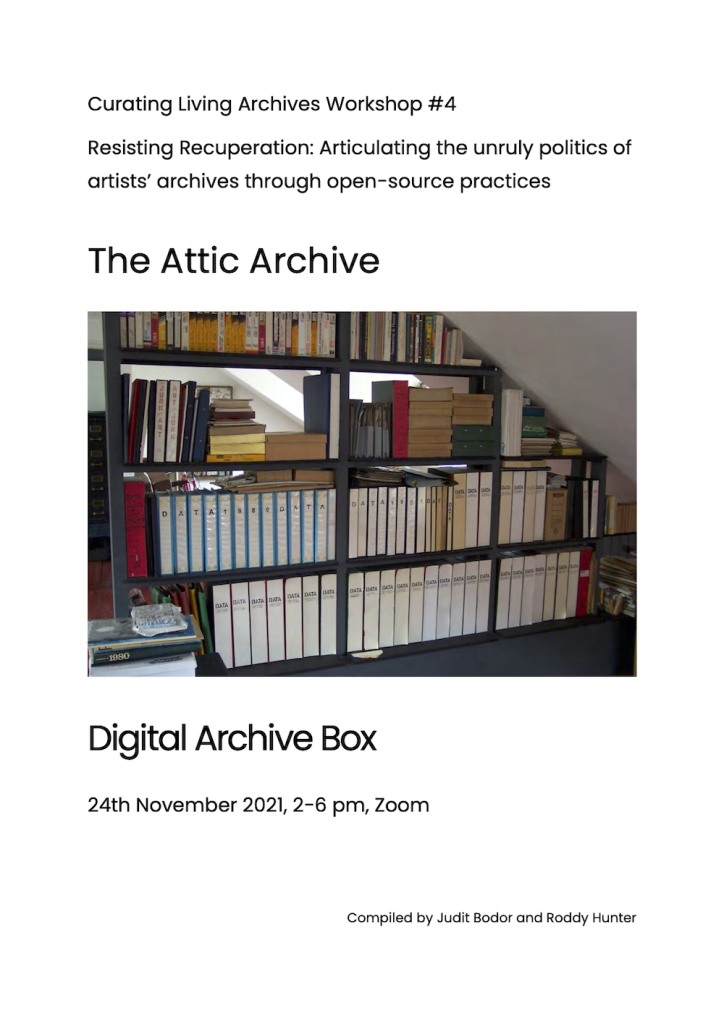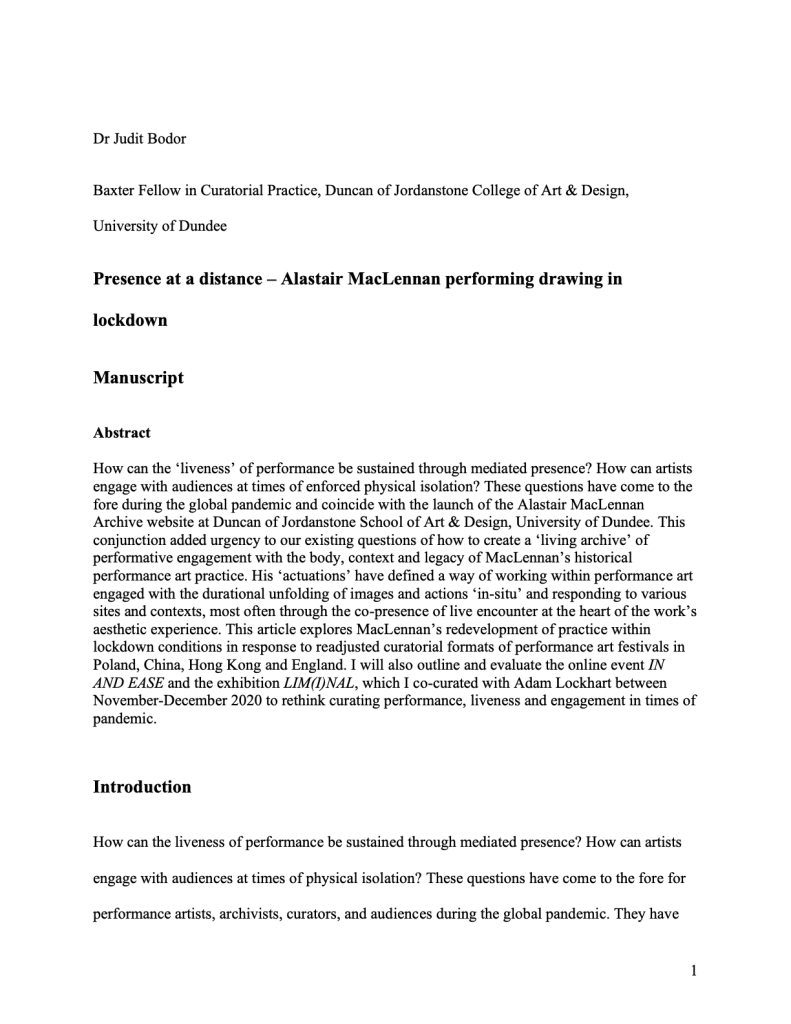

By: Miriam Mallalieu
For the best experience open this page on desktop

By: Miriam Mallalieu
For the best experience open this page on desktop

By: Miriam Mallalieu
For the best experience open this page on desktop

‘In Two Minds’ was first performed at the Project Arts Centre in Dublin in 1978. For this video/performance, Kevin Atherton recorded a series of questions-to-camera in the gallery during the daytime which he then answered live in front of an audience the same evening. Sitting opposite the playback of the video recording, screened on a monitor facing him, Atherton answered the questions to the amusement of the audience sitting either side of him at the gallery. Within weeks he repeated the performance in Belfast and in Farnham, each time recording a new ‘question tape’. These ‘question tapes’ varied from one another, picking up on the specifics of the different venues, but in general, in all the artist talked about issues to do with performance and video art as emerging art forms. To save money the tapes were recorded over and consequently lost forever.
In the spring of 1978 Atherton was selected by artist Stuart Brisley to be in a group exhibition at the Serpentine Gallery in London. For this exhibition, Atherton decided to re-make ‘In Two Minds’ as a two-monitor installation with the recorded questions on one monitor and the recorded answers on the other. The monitors faced one another across the space, continuously playing his questions and answers in sync, whilst the audience could sit on benches on either side of the gallery following the installation ‘Wimbledon style’.
With one or two exceptions (eg. a performance at De Lantaren, Rotterdam, 1980), Atherton left the work alone for a number of years thinking that the installation at the Serpentine Gallery had brought it to its natural conclusion. It wasn’t until 2000, when invited to give a lecture, that he realised that rather than talking about ‘In Two Minds’ in retrospect, he could talk to ‘In Two Minds’. By answering the 1978 questions live in 2000 in the lecture theatre, he created a new viewing experience and opened up a number of aspects to the work that emerged since its conception because of the passage of time. Further live performances happened in Tate Britain 2006, FACT 2007.
All new versions of the work since 1978 (including live performances in Tate Britain 2006, FACT 2007, Newcastle, 2011, Tate Britain, 2012, and Sirius Art Centre, Cork 2018; and installations at MOMA, San Francisco, 2009, the Irish Museum of Modern Art, 2014) with the time gap ever-widening, have used the surviving 1978 Serpentine installation ‘Question Tape’ as the recording that Atherton responds to.
In addition, in 2011 the artist exhibited 3 video versions of the work at once as part of ‘IN TWO MINDS x3’ exhibition at Golden Thread Gallery, Belfast. This exhibition not only included ‘The original version’ (1978) alongside a ‘Past Version’ (1978-2006), but also a ‘Future Version’ (1978-2031)’, in which the 56 years old artist talks to his future ‘virtual’, 81-year self, discussing artworks and events yet to occur.
Artist: Kevin Atherton
Title: In Two Minds
Year: 2014
Archive: Courtesy of the artist
By: Miriam Mallalieu
For the best experience open this page on desktop

As part of Curating Living Archives artist and writer, Miriam Mallalieu, was commissioned to follow the workshops and map out key points discussed amongst the participants. Miriam used a process of observation, notetaking and recollection to create these records of the events, which, like constellations, map out fragments of ideas, statements and conversations. These records are deliberately incomplete: they are not able to capture and reproduce the events, but offer something new through the assemblage of scattered traces. They fold together ideas that emerged in the workshops: traces, ghosts, unruliness, control, affect, disappearance, witnessing, shifting.
The title of the work Fragments coming together to constitute new realities and new futures is a quote from the third workshop, shifted into a new context of describing the process of capturing these workshops.
Comissioned artist researcher
Miriam Mallalieu is an artist whose practice balances sculpture and storytelling, but also includes film, print and publication. Her doctoral research What does a museum think it is? Research and practice at the intersection of knowledge, interpretation and organisation (Duncan of Jordanstone College of Art & Design, 2018-2022) focused on ideas of ‘making sense.’ Through a methodology that she describes as ‘provocation through disruptive taxonomy’ she uses processes of reorganisation, repetition and deconstruction to draw attention to the structures by which things are understood. Her current project explores how objects in museum collections are changed through their context. Key issues include implications of active and passive objects, questions of significance, value and narrative, subjectivity and politics of collection, and how all of these contribute to form a structure that holds claim to universal or encyclopaedic representation.

How can the liveness of performance be sustained through mediated presence? How can artists engage with audiences at times of physical isolation? These questions have come to the fore for performance artists, archivists, curators, and audiences during the global pandemic. They have been no less impactful for a collaborative curatorial project I initiated around the Alastair MacLennan Archive at Duncan Jordanstone School of Art & Design, University of Dundee. In this project, the experience of ‘presence at a distance’, whether in space or time, was explored to create a ‘living archive’ of performative engagement with the body, context and legacy of MacLennan’s practice. MacLennan’s ‘actuations’ have defined a specific mode of performance art that is engaged with the durational unfolding of images and actions ‘in-situ’ in response to a range of sites and contexts, and most often with a sense of live encounter, or co-presence, at the heart of the work’s aesthetic experience. His live work is typically presented in performance art festivals and so dependent on international mobility, which has ceased due to COVID-19 related restrictions. Conceiving a curatorial project engaging with the artist’s physical archive became increasingly difficult in logistical terms during the pandemic due to restrictions on physical exhibition making and public assembly. We found the eventual solution to this and broader questions of overcoming the gap between performance and its reception in time and space in the artist’s redevelopment of practice within lockdown conditions. Unable to travel and confined to either his home or studio in Belfast, MacLennan’s daily drawing practice became a prolific and multi-faceted approach to performance that enabled him, through working with Jordan Hutchings, to produce new photographic and video-based work VIAL AVAIL.
This single-authored peer-reviewed article explores how this new body of work was made in response to the adjusted curatorial formats of performance art festivals in Poland, England, China, and Hong Kong. It also outlines and evaluates in comparison Bodor’s role as a companion to this process in co-curating, with Adam Lockhart, the event IN AND EASE and exhibition LIM(I)NAL to rethink curating performance, liveness and engagement with audiences online in the times of a pandemic.
The essay offers a case study in curatorial practice-as-research addressing how liveness might function on a digital platform, and how it might be possible to open a way to develop an archive as an active, performative curatorial project especially at times when physical archives might be inaccessible. Published in Performance in a Pandemic, a Routledge collection that gathers leading UK and international artists, academics, and practitioners in the fields of contemporary performance, dance, and live art to offer creative-critical responses to the impact of COVID-19 on their work.
Alastair MacLennan’s VIAL AVAIL was one of the examples of artworks discussed also in the workshop ‘Curating as Expanded Conservation’ on 18 November 2021.
The video is a recording of Holly Davey’s presentation introducing A Script for an Archive: Women, at the artwork’s launch on 31st January 2022.
A list of resources and research material used by the artist during her research for A Script for an Archive: Women:
Linda Nochlin: ‘From 1971: Why Have There Been No Great Women Artists?’, ArtNEWS, 2015. A revised version of an article originally published in 1971.
‘A Vindication of the Rights of Woman: with Strictures on Political and Moral Subjects’. A Wikipedia page about one of the earliest works of feminist philosophy written in 1972 by Molly Wollstonecraft.
Why Were Women Written Out of History? An Interview with Bettany Hughes. [blog post] English-heritage.org, 2016.
Jackie Hatfield’s interview with Catherine Elwes, 2006.
Catherine Elwes: The Critics Informed Viewing, 1982.
Jackie Hatfield’s interview with Tina Keane, March 2005.
Tina Keane: Bedtime Story, 1982.
Maggie Warwick’s interview with Judith Goddard, March 2007.
Judith Goddard: Lyrical Doubt, 1984.
Transcription of Maggie Warwick’s interview with Rose Garrard, April 2008.
Rose Garrard: Pandora, The Bringer of Gifts, 1983.
Rose Garrard: Tumbled Frame, 1984
Jackie Hatfield’s interview with Katherine Meynell, June 2006.